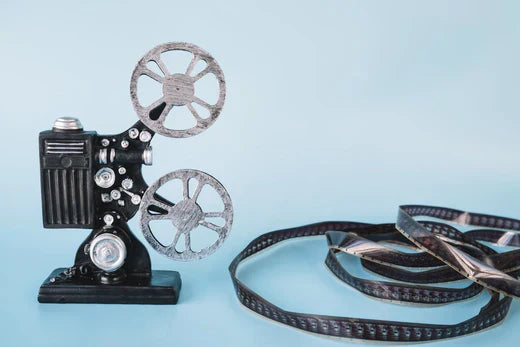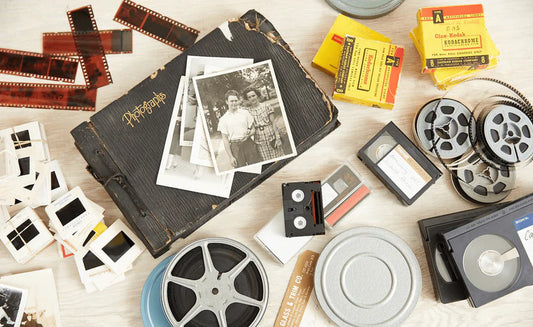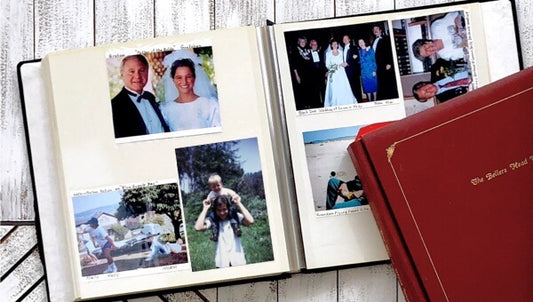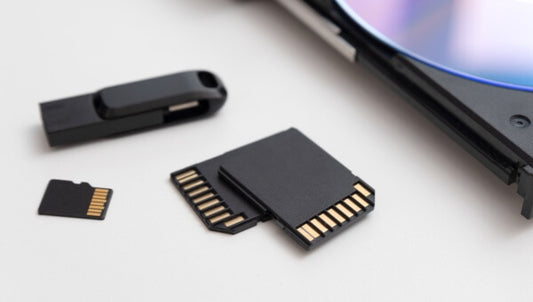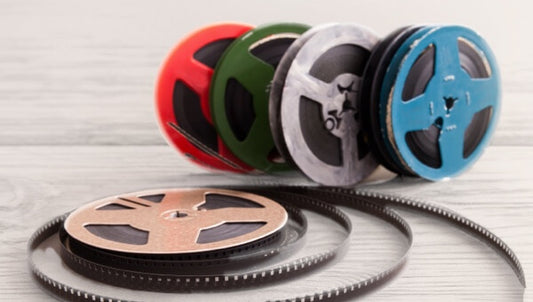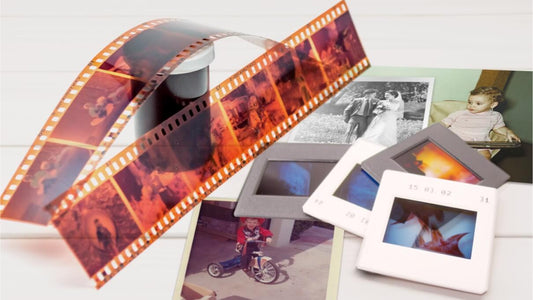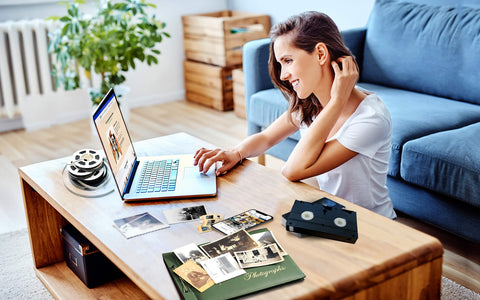Super 8 film used to be the go-to for amateur filmmakers and home movies. While it was largely replaced by videotapes and then digital formats, there has been a resurgence in popularity because of the nostalgic image quality, film flexibility, and fun handheld film cameras.
Throughout the last more than 20 years, Capture’s archival experts have learned all there is to know about different types of film, including Super 8 film. We compiled all the most important information into this blog to help you get started with Super 8.
Keep reading to learn about the history of Super 8 film, differences between Super 8 and other movie film formats, and information about Super 8 film cameras, shooting film, and preserving your film memories.
Jump to:
- History of Super 8 Film
- Differences between Super 8 Film and Other Formats
- Super 8 Film Cameras and Equipment Shooting and Processing
- Super 8 Film Super 8 Film Preservation and Digitization
- Where to Buy Super 8 Film
- Super 8 Film Festivals and Communities
- Conclusion
History of Super 8 Film
If you’re wondering, “What is Super 8 film?” then it’s a good idea to start with the history. Super 8 film was released in 1965 by Eastman Kodak as an upgrade to standard 8mm film (which was an upgrade from 16mm film), Super 8 is still an 8mm magnetic tape, but it had smaller sprocket holes that allow for higher image quality due to a bigger exposure area.

Super 8 film was popular for its ease of use and high-quality home movies.
Additionally, the Super 8 cartridge was easier to load into a film camera, which made it easier to capture home movies of special events, family gatherings, and day to day experiences. Then, in 1973, Kodak upgraded Super 8mm film once again by using a larger spool that could record sound.
While other types of film and videotapes began to replace Super 8 in the 1980s, many music videos continue to use Super 8. That popular use has continued through the recent resurgence of interest in Super 8 as well as recent music videos using Super 8 including Watermelon Sugar by Harry Styles.
Throughout the history of Super 8, other innovations have been made. While Kodak eventually discontinued the most popular Super 8 cartridge, the Kodachrome, they released the Kodak Ektachrome color reversal film cartridge in 2019 to meet the growing demand for Super 8 film.
Cartridge Design and Ease of Use
Super 8 film became popular due to its easy-to-load cartridge design. Unlike earlier formats that required threading, Super 8 cartridges were self-contained, making it ideal for beginners and families. The design helped reduce accidental exposure and damage. The cartridge also featured a notch system to automatically detect film speed, eliminating the need for manual ISO adjustments.
Film Types and Processing
Super 8 film comes in various types, each with unique characteristics. Kodak’s Tri-X black and white reversal film offers a classic look, while Ektachrome 100D provides vibrant colors for daylight shooting. Vision3 color negative films - 50D, 200T, and 500T - are suitable for different lighting conditions. Select the right film based on your shooting environment: daylight-balanced films for outdoor scenes and tungsten-balanced films like 500T for indoor or low-light settings.
Differences between Super 8 Film and Other Formats
During the 20th century, there were three major motion picture film formats: 16mm, 8mm, and Super 8. Standard 8mm was introduced as an affordable alternative to 16mm black and white or color negative film. It offered twice the number of perforations and could be recorded on both halves of the width.

Super 8 offers better sound, a larger frame, and sharper picture than 8mm.
If you want to know what is the difference between 8mm and Super 8 film, the main differences between Super 8 and 8mm start with sound. Whereas older film formats like 16mm and standard 8mm film could never record sound, some Super 8 film offered sound quality. You can identify sound capability by looking for a rust-colored strip on one side of the film.
Another difference is the frame size. 16mm film has a frame size of 10.26mm x 7.49mm while both Super 8 and 8mm film stock have 8mm in width. However, Super 8 has a slightly larger frame size than standard 8mm as well.
Additionally, Super 8 offered a sharper picture while still retaining the analog film graininess and unique aesthetics that are cherished for movie-making today. Many short films prefer the nostalgic, slightly imperfect appearance of Super 8 film because they can bring certain emotions, images, and experiences to life.
Super 8 Film Cameras and Equipment
If you want to start shooting Super 8 home videos, then you’ll need to know a little about what is Super 8 film equipment. During the 1960s, Super 8 cameras could only film at 18 frames per second, but as technology progressed many Super 8 cameras began offering 24fps, the motion picture standard as well as faster speed for slow-motion filming.

Super 8 cameras vary in features, from basic models to high-end ones like the Beaulieu 4008.
There was an abundance of Super 8 cameras made throughout the 1970s by major brands like Fujifilm, Canon, and Bell and Howell. Each model offers a unique set of features including superimposed viewfinder displays, interval shooting, auto zoom systems, interchangeable lenses, and more.
With plenty of cameras to choose from, you can weigh features and budget to find your Super 8 camera. Options like the Beaulieu 4008 are beloved by short film enthusiasts and movie aficionados because of the up to 70fps, macro zoom, and flexibility, but will cost more than other good cameras.
For modern functionality combined with Super 8 aesthetic, you can try the Canon 1014 or go with a budget friendly option like the Kodak Instamatic M4 Movie Camera. Whatever you choose, you need to make sure it offers the features designed for your purpose whether you plan on capturing family memories or creating a cinematic masterpiece.
In addition to a Super 8 camera, you will need Super 8 film. You can currently buy Super 8 film from Kodak including black and white Tri-X film and Ektachrome color reversal film. You can also get straps, additional zoom lenses, tripods, and other equipment for a better Super 8 shooting experience.
Shooting and Processing Super 8 Film
To shoot high-quality home movies, you need to know how to shoot Super 8 film properly. The first step comes with buying the right type of film. If you are shooting outside, make sure you get daylight film and with interior lighting, you’ll need ISO tungsten film. Additionally, you can choose either black and white film or color film.

Preserve your Super 8 film by digitizing it to protect against damage and ensure future generations can enjoy it.
We recommend starting with your goals. For example, if you want to preserve family memories, then make sure you know the length of the film and the events you want to capture. If you want to create a fictional motion picture, then you’ll want to plan out the project with a storyboard. Basically, plan and learn how to use your Super 8 camera before shooting the final project. Also, buy extra film!
While shooting Super 8, make sure you keep your eye on the reel counter and exposure. Overexposure or underexposure can ruin your film and colors. You’ll also want to make sure to make transitions between scenes. For example, if you want to film a wedding and then a reception, make sure that the change isn’t too jumpy.
Practice with zoom features, different lenses, focusing, and other features before shooting. That way, you can use them during your project without missing some of the important action. Finally, make sure you keep the lens clean every time you stop filming.
After you’ve finished shooting the entire cartridge, you’ll need to remove the cartridge and send it in for processing and development. Some local stores will process your Super 8 film, but if not, you can use an online provider like Pro8mm.
Super 8 Film Preservation and Digitization
While Super 8 films are still popular for filmmakers and home movies, it’s not easy to share with loved ones online. Additionally, while it can last as long as 70 years in good condition, it will not last forever. It can be damaged by moisture, heat, sunlight, and other elements and could cost you to lose your memories and motion pictures forever.

That’s why it’s so important to preserve your Super 8 footage by digitizing it. You can do this yourself using a film scanner machine like the Kodak REELS film digitizer. While it’s time-consuming and costs around $400, it will preserve your memories as digital copies that you can save and view on almost any device.
Another option is to use a professional film digitization service like Capture. We’ll preserve your Super 8 film at the highest possible quality while ensuring your original film is safe through every hand and all the way back to you. Plus, we offer a satisfaction guarantee and industry-leading 30 day turnaround time.
Regardless of how you digitize and preserve your Super 8 film, it’s an important step to ensure your Super 8 memories last forever for future generations to share and enjoy.
Where to Buy Super 8 Film
Super 8 film is sold in specialty camera, and film stores as well as some drug stores, but it’s often cheaper and easier to find online from places like B & H Photo Video or Pro8mm. In fact, you can even find Super 8 film on Amazon.
Kodak currently makes three types of film for Super 8 cameras including Kodak Vision 3 (color negative film 50D, 500T, and 200T), Tri-X reversal film 7266, and Ektachrome 100D color reversal film. Make sure you pick out the one that works best for your project.
Finally, if you want another place to learn more about Super 8 cameras and film and learn where to buy more equipment, film reels, and accessories, try finding a local store, club, or community or join one online.

Super 8 film is available online from retailers like B&H Photo Video, Pro8mm, and Amazon.
Super 8 Film Festivals and Communities
There are several Super 8 festivals and competitions annually that you can join to learn more about Super 8 and interact with other filmmakers who’re interested in creating films with analog formats. This includes:
- The 8 Fest
- the United States Super 8mm Film & Digital Video Festival
-
and countless local and regional events
Additionally, you can ask questions, share tips, showcase films, and more with online Super 8 communities like:
- the 8mm forum
- Reel Magic Film Forum
- the Super 8 section of cinematography.com
There are also sections of Reddit that focus on analog film and Super 8.
These events and communities can help you develop better Super 8 shooting skills, become part of the resurgence in Super 8 popularity, and learn tips and tricks for filming.

Join Super 8 festivals and online communities to connect with fellow filmmakers and enhance your skills in analog filmmaking.
FAQ
- How much does the Super 8 film cost? Prices vary, but most cartridges cost between $25–$50 depending on the brand and type.
- Can you still get Super 8 film developed? Yes, several specialty labs offer development and even digital scanning services.
- Is the Super 8 film still made? Yes, companies like Kodak still manufacture new Super 8 film stocks.
- Does Super 8 film expire? Yes, like all film, it expires. Store it in a cool, dry place to extend its shelf life.
- How long does 50 feet of Super 8 film last? It runs for about 3 minutes at 18 fps (frames per second).
- How to choose a Super 8 film? Choose based on lighting conditions (daylight vs tungsten), color vs black and white, and your subject.
- How do you clean old Super 8 film? Use film-safe cleaner and soft lint-free cloths. Avoid water or alcohol-based products.
- Does anyone develop Super 8 film? Yes, many online and local labs like Pro8mm still develop Super 8 film.
Preserve Your Super 8 Film for Future Generations
While Super 8 was most popular before the videotape wars, there has been a recent resurgence in using this format for amateur filmmaking and home movies because of the iconic image quality and aesthetic. Now that you know what is Super 8 film and how to choose the right type of film, find the best Super 8 camera, and use best practices, you can create distinct home movies that capture your memories and events.
However, Super 8 film only lasts so long, so it’s important to convert Super 8 film to digital to preserve the memories forever. Capture can preserve your film in high-quality format and even create DVD or USB flash drive copies of your analog moments.



